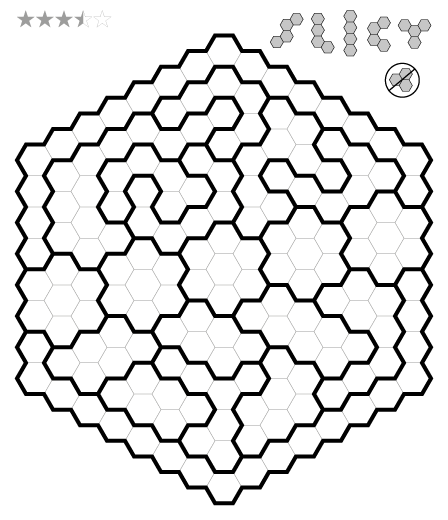SLICY by Thomas Snyder

or solve online (using our beta test of Penpa-Edit tools)
Theme: Mini Hexes
Author/Opus: This is the 384th puzzle from Thomas Snyder, aka Dr. Sudoku.
Rules: Variation of LITS. Shade exactly four cells in each outlined region to form an S, L, I, C, or Y tetrahex. When all regions have been shaded, the following conditions must be true:
1) All shaded cells will be connected through a network of adjacent shaded cells;
2) No three shaded cells will share a common vertex;
3) When two tetrahexes share an edge in adjacent regions, they must not be the same type (S, L, I, C, or Y), regardless of potential rotations or reflections.
Difficulty: 3.5 stars
Time Standards (highlight to view): Grandmaster = 5:00, Master = 8:00, Expert = 16:00
Solution: PDF; a solution video is also available here.
Note: Follow this link for more variations of LITS and this link for classic LITS. If you are new to this puzzle type, here are our easiest LITS to get started on. More LITS puzzles can be found in LOTS O’ LITS by Grant Fikes and Prasanna Seshadri, in The Art of Puzzles 2, and in our beginner-friendly collection Intro to GMPuzzles by Serkan Yürekli.

Hi, just FYI, I tried to use GR (dark gray) for the solution (which the rules say should work), but I had to shade over them all with black for the solution checker to work.
Hi Michael,
I think Dark Grey is DG (which is the default choice when the link is opened). I just solved with Dark Grey (DG) and the answer check worked for me.
Just a note that I found the two valid options (including the default) of black and dark gray both hard to use for solving. The problem is that they blend in with the region borders making it hard to still see the borders once some cells are marked.
I ended up solving in blue instead, and then having a moment of confusion when I reached the end, didn’t get the confirmation, and couldn’t find my mistake anywhere.
I suppose the handiest feature would be to extend the answer checker to validate any solution that matches the correct solution consistently, (regardless of which color the solver used).
I have to agree with Carl – neither of the current solution checker options are great for shading puzzles with regions. If it’s too difficult to check for any consistent color, maybe just add one extra color to the current check?
(Alternatively, maybe make it so any shading *other* than green counts… that would also let me use my usual approach of assigning different colors to the different shapes.)
@Carl @Michael
I definitely don’t want to add all the colors for answer checks, because there are many other puzzles where people use other colors for helper notes. Unfortunately, currently, I cannot assign puzzle-specific rules in Penpa, maybe in the long run when I introduce puzzle tagging.
But I agree about the scanning issue, which is why in the next update, I will probably be adding the other two grey shades as well (GR and LG) to answer checking and I believe that should resolve the scanning issue in the shading puzzles. I have already made this change on the public penpa version (https://swaroopg92.github.io/penpa-edit/) if you want to give it a try.
@Swaroop: Either of those would do the trick as far as I’m concerned. Thanks for the speedy response 🙂